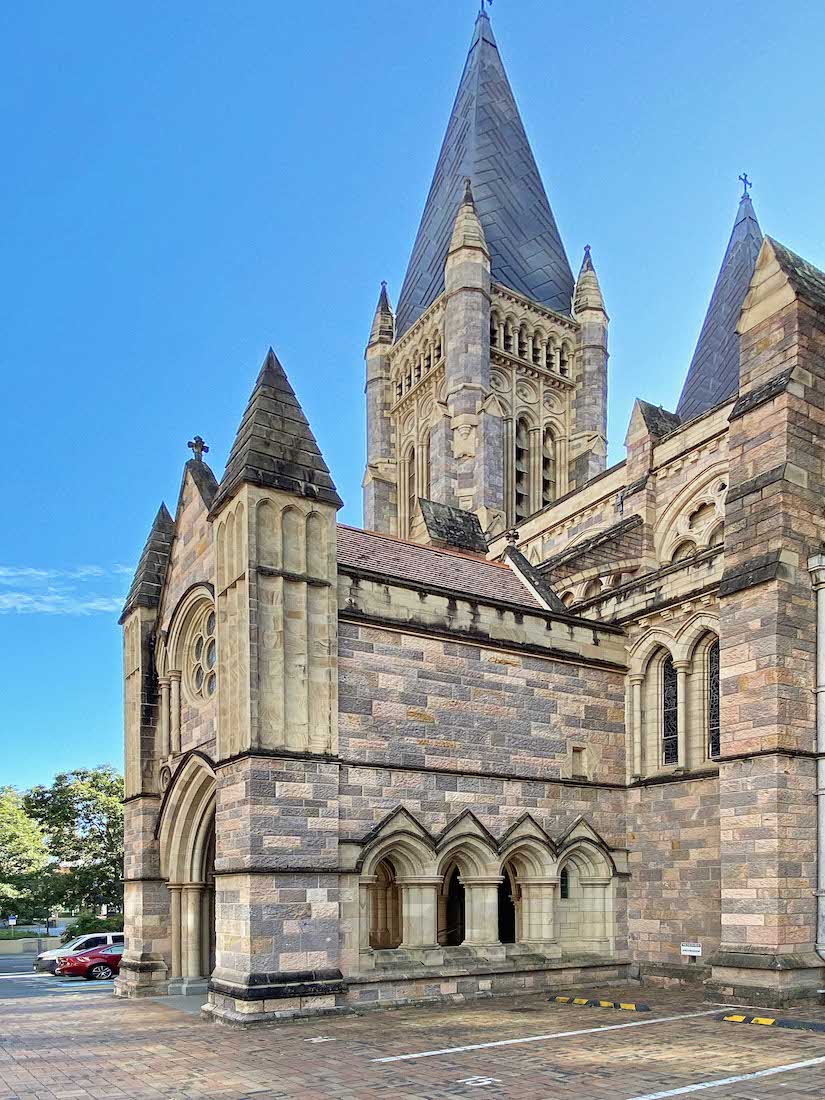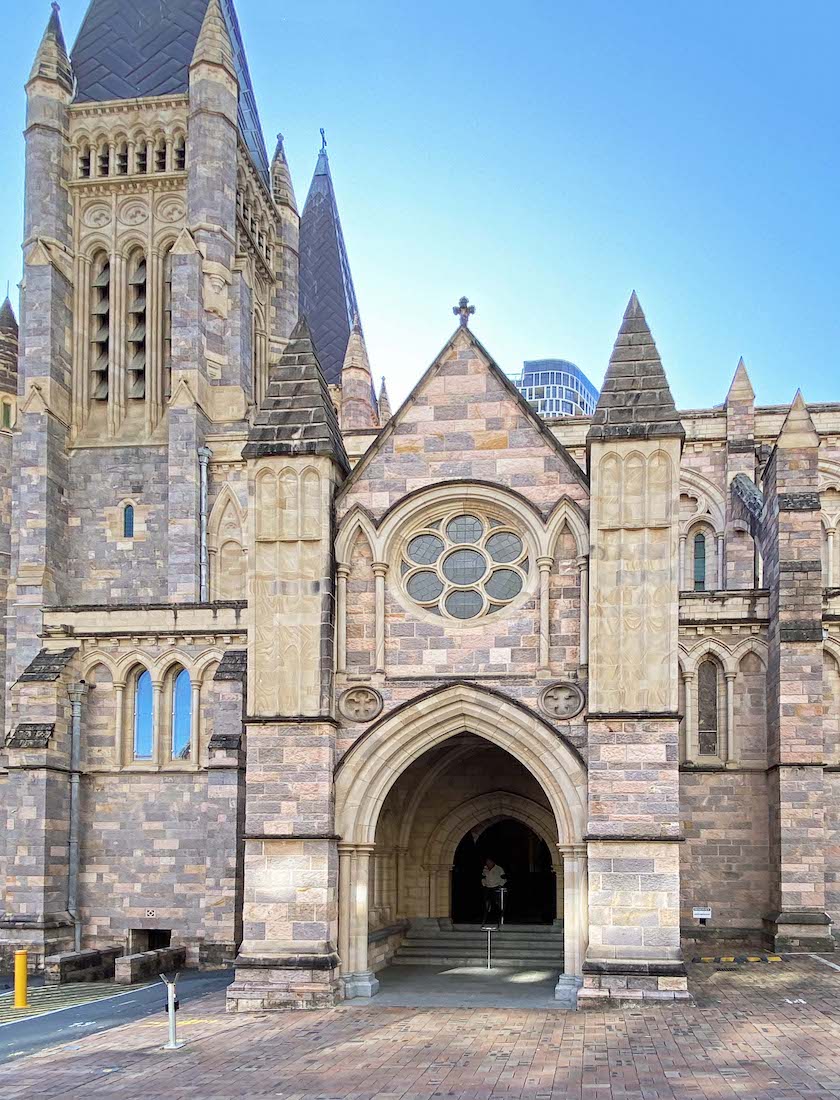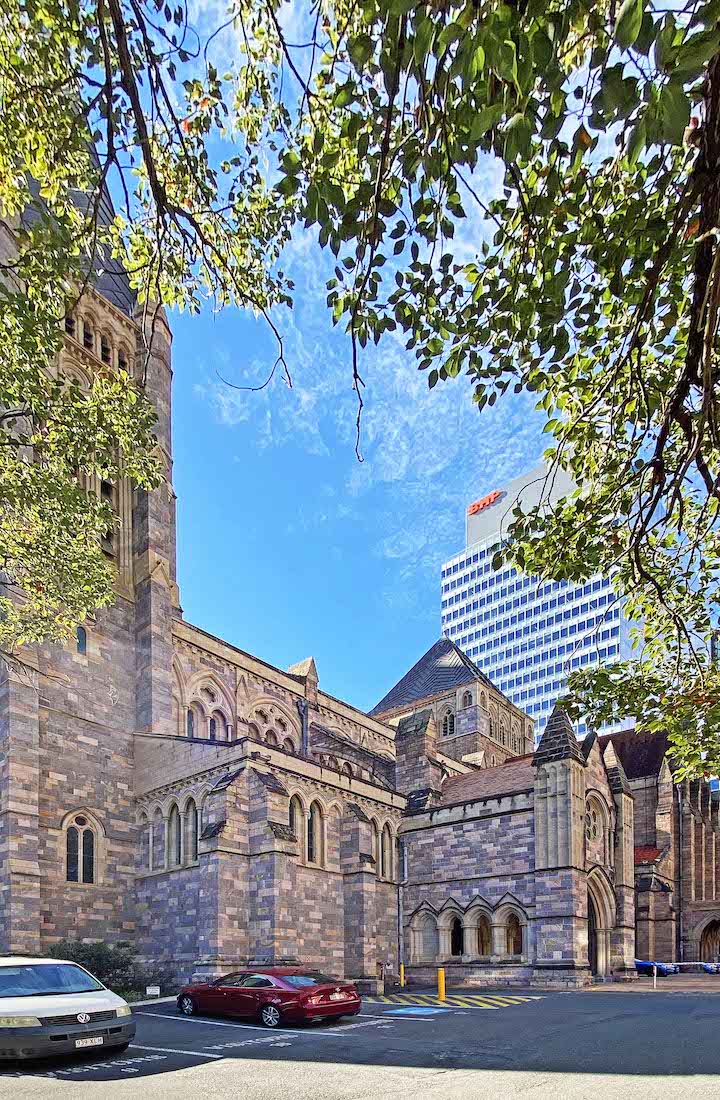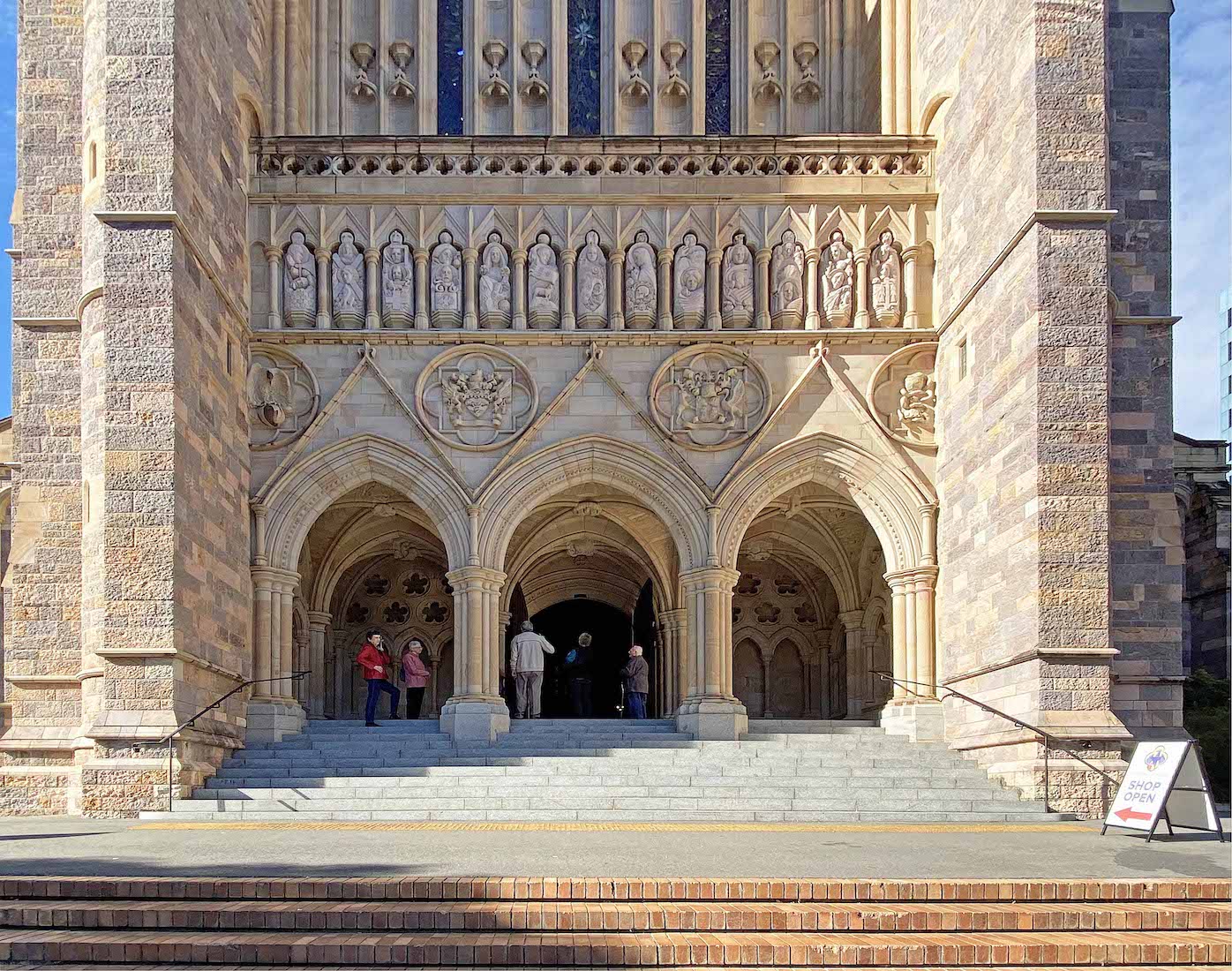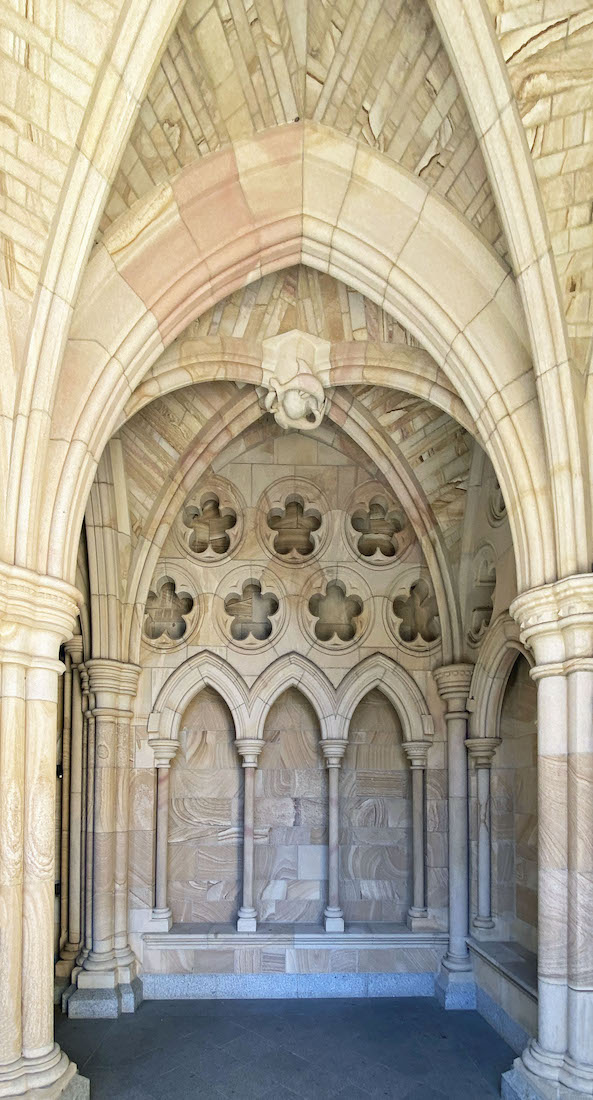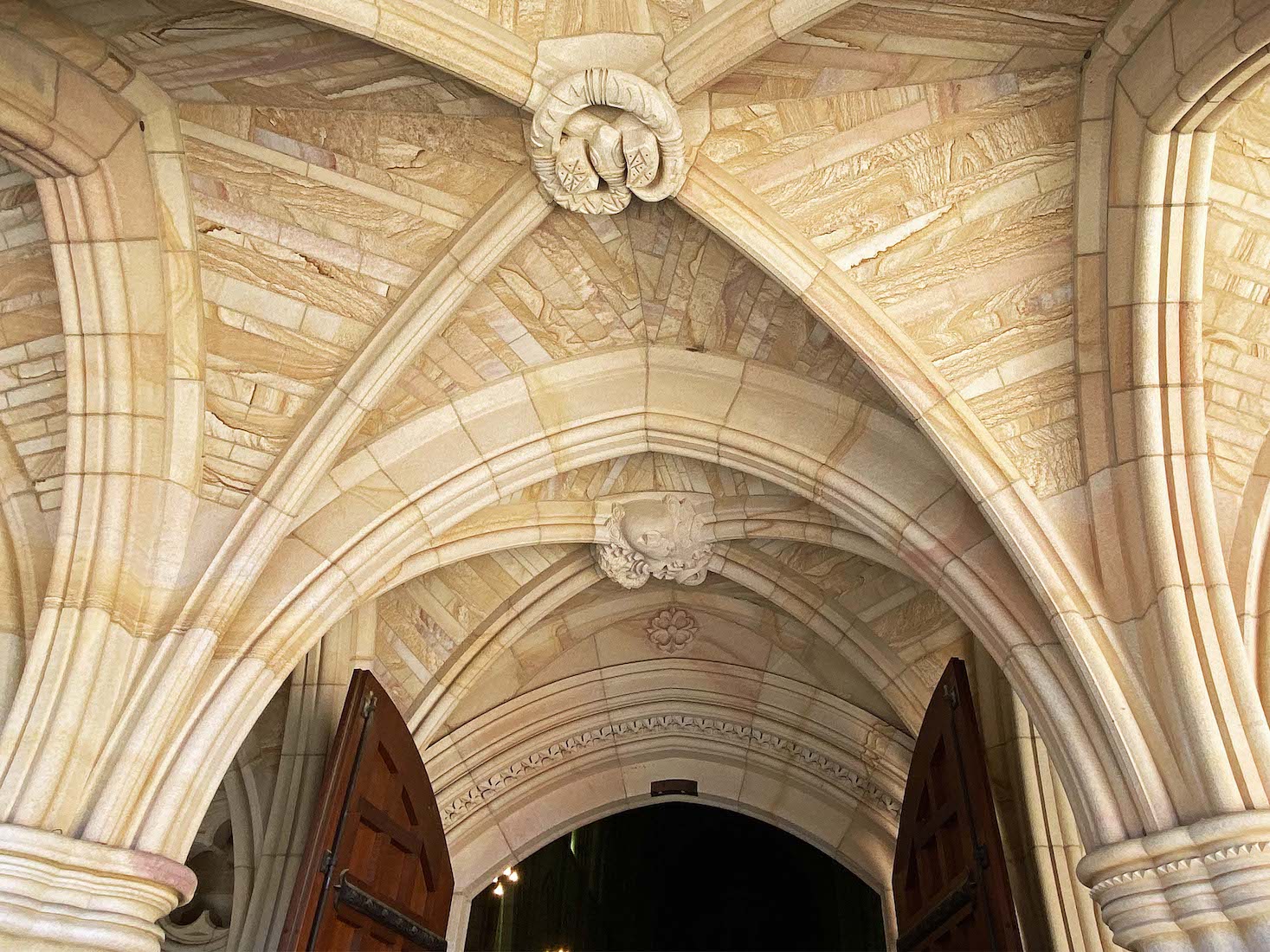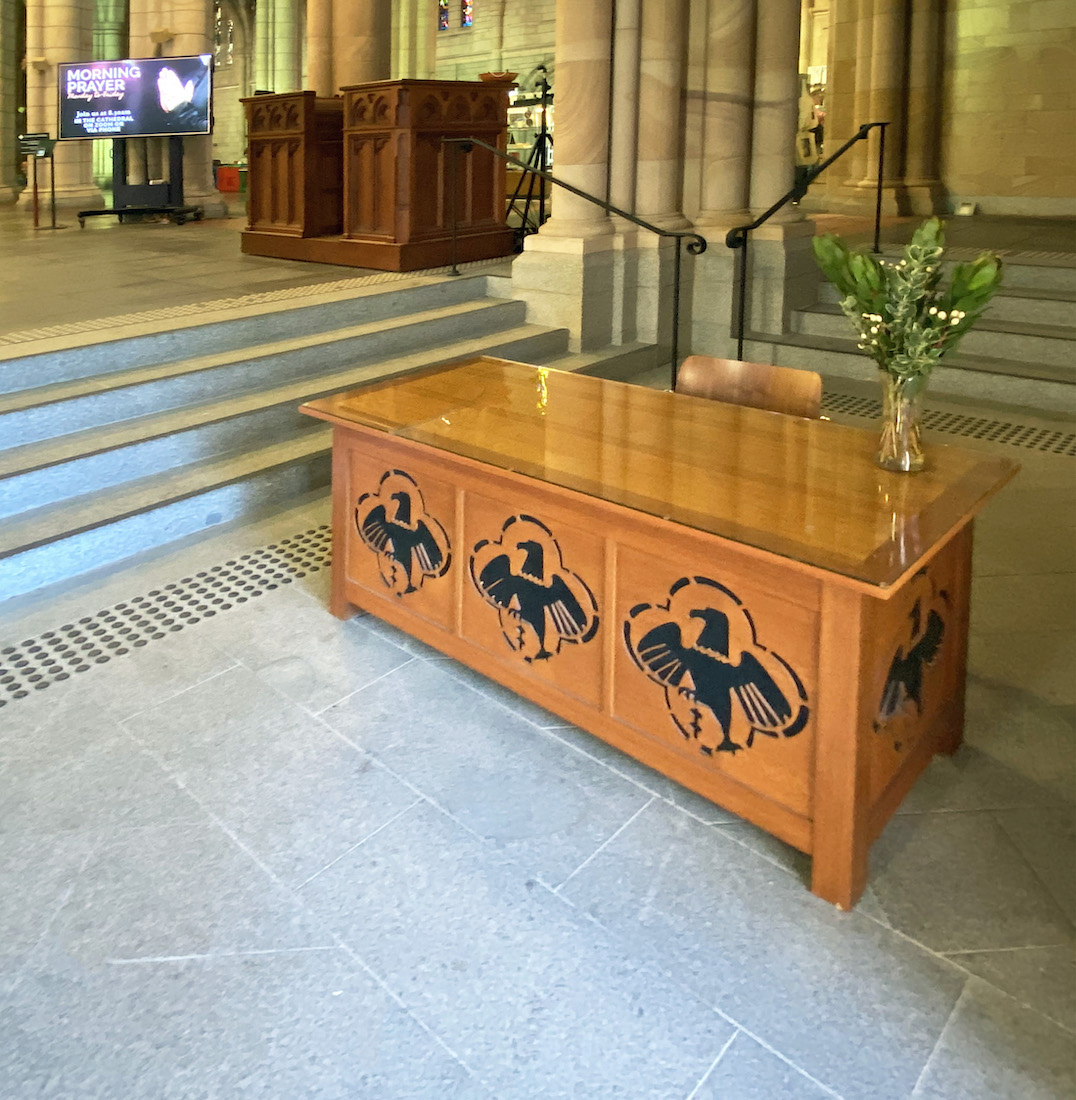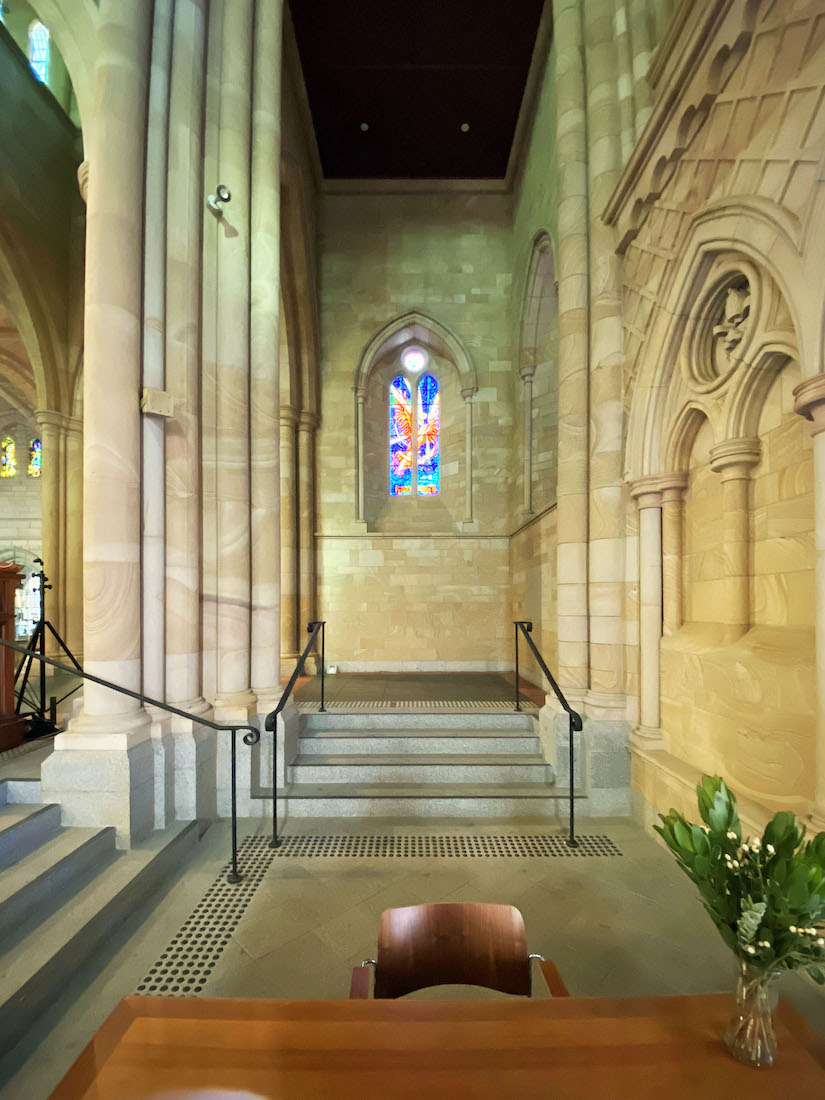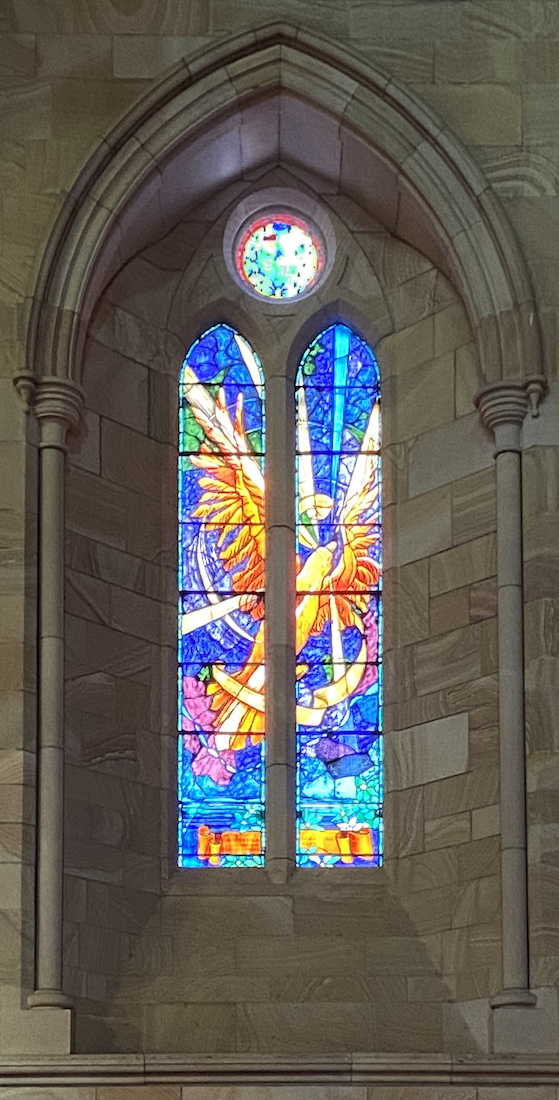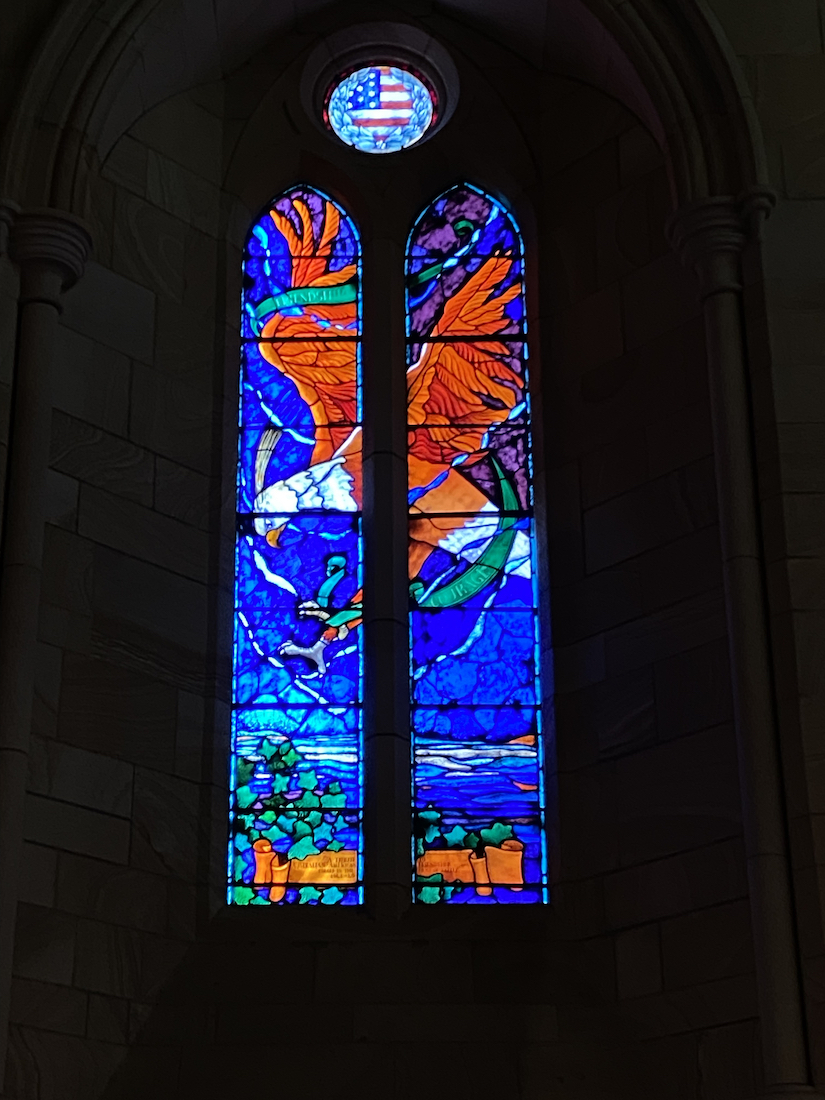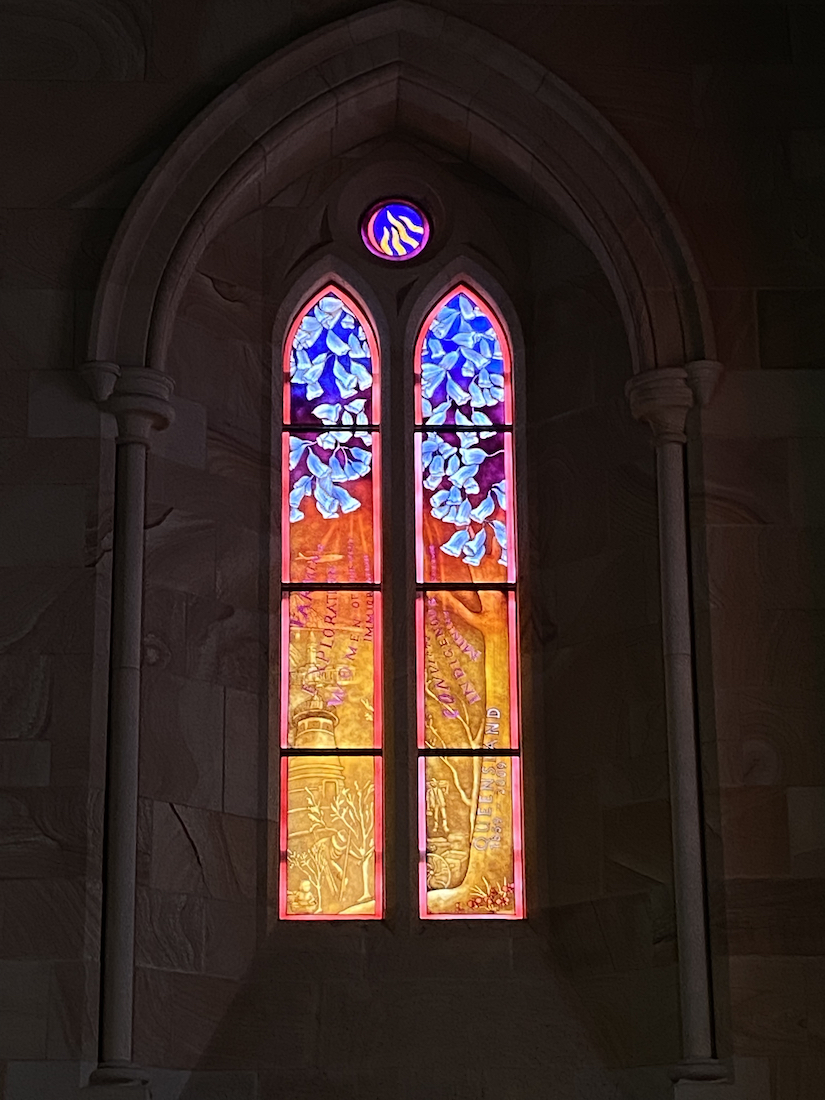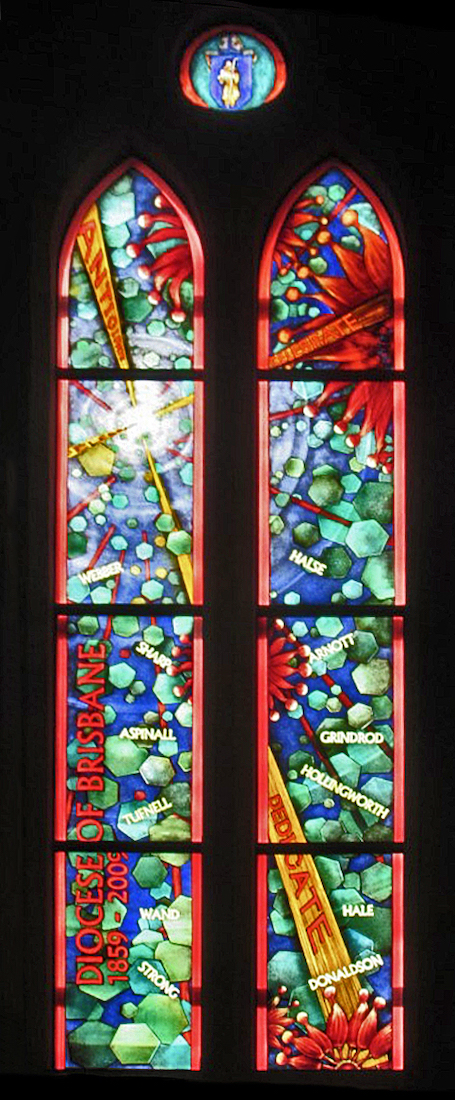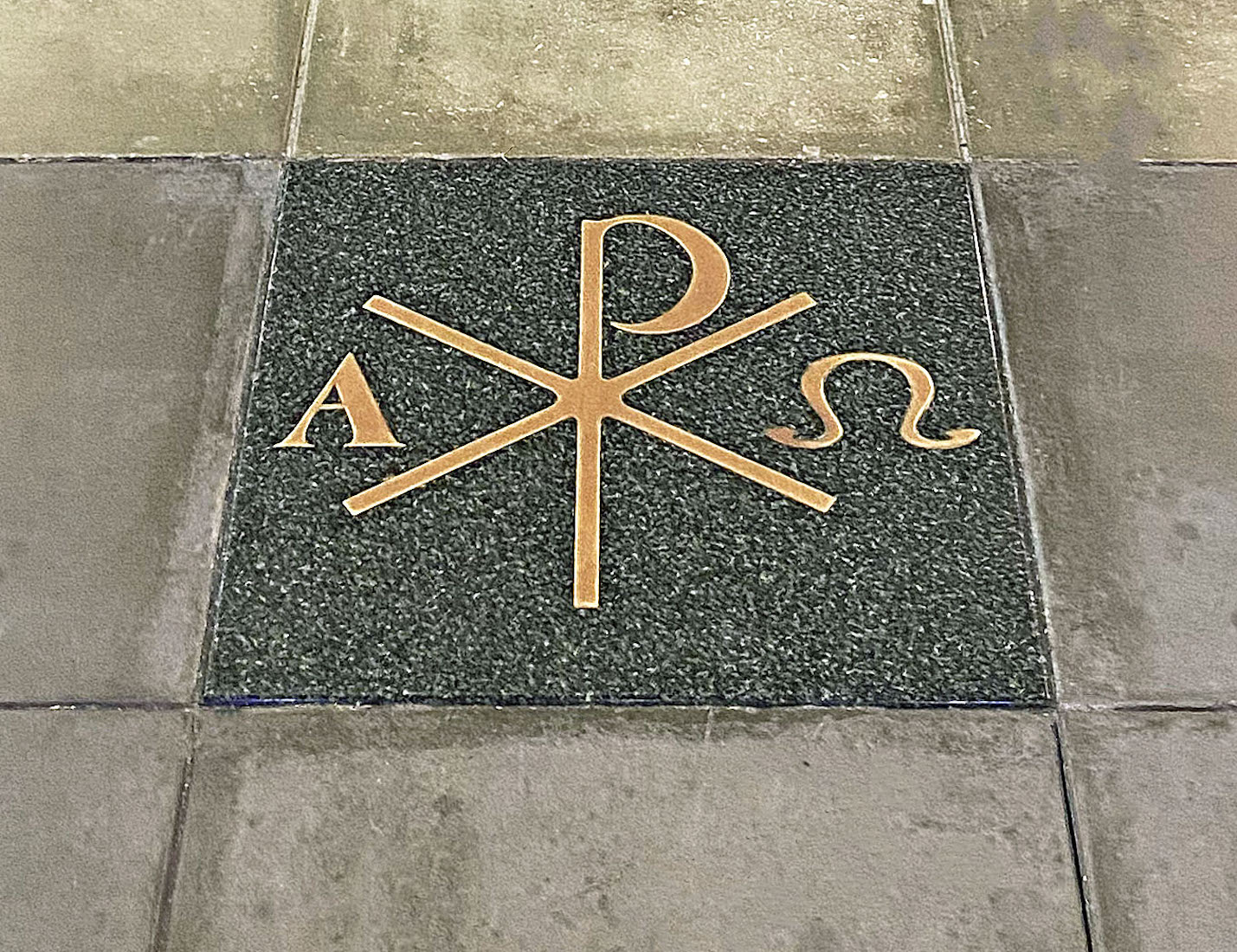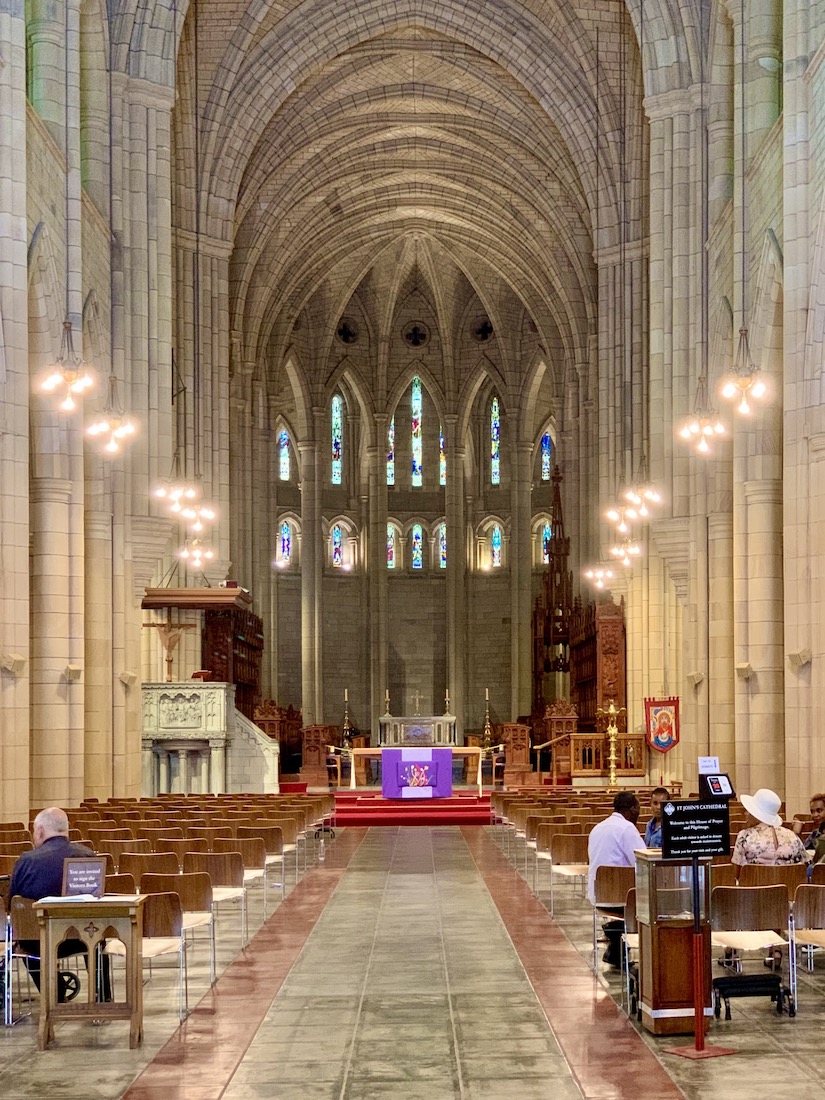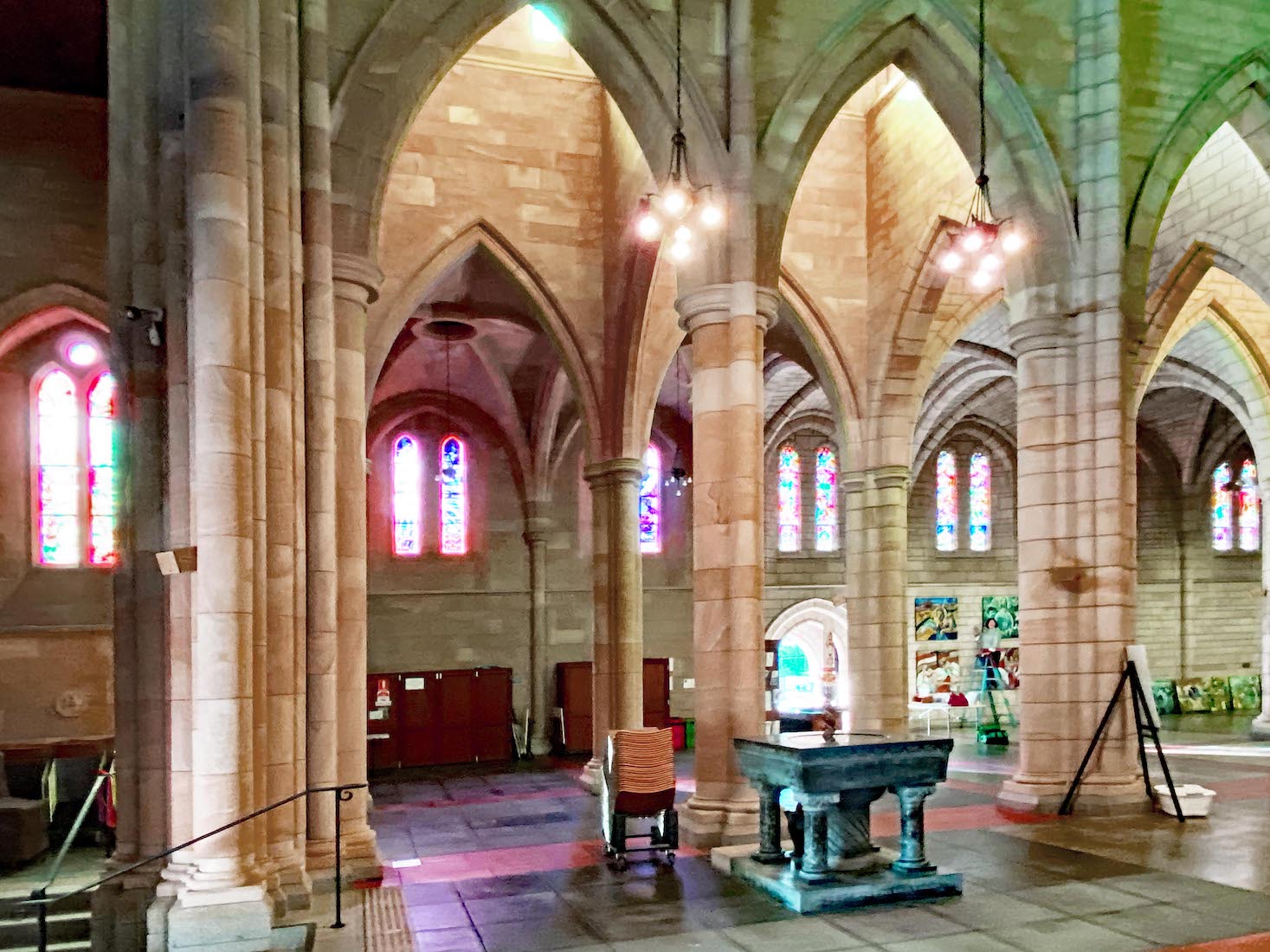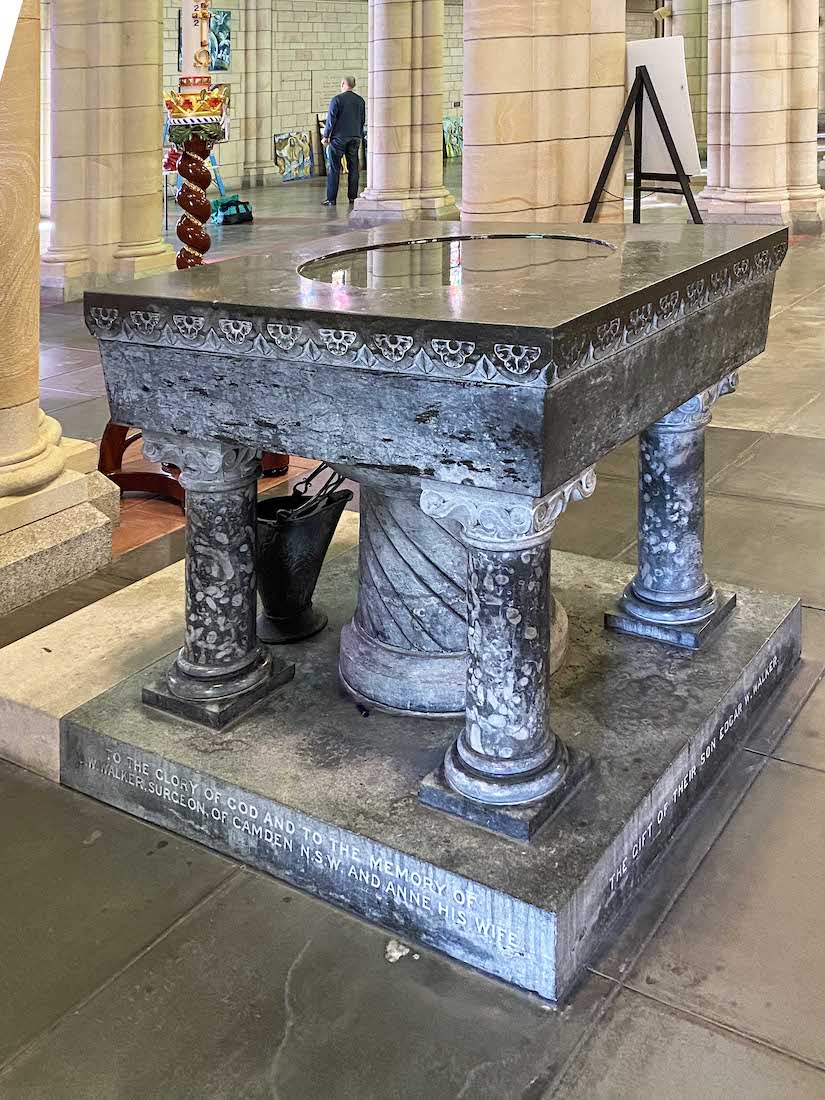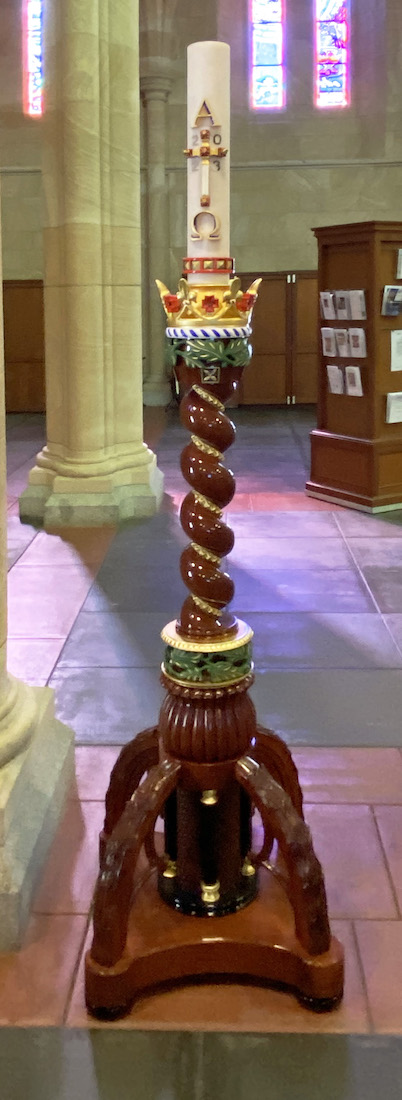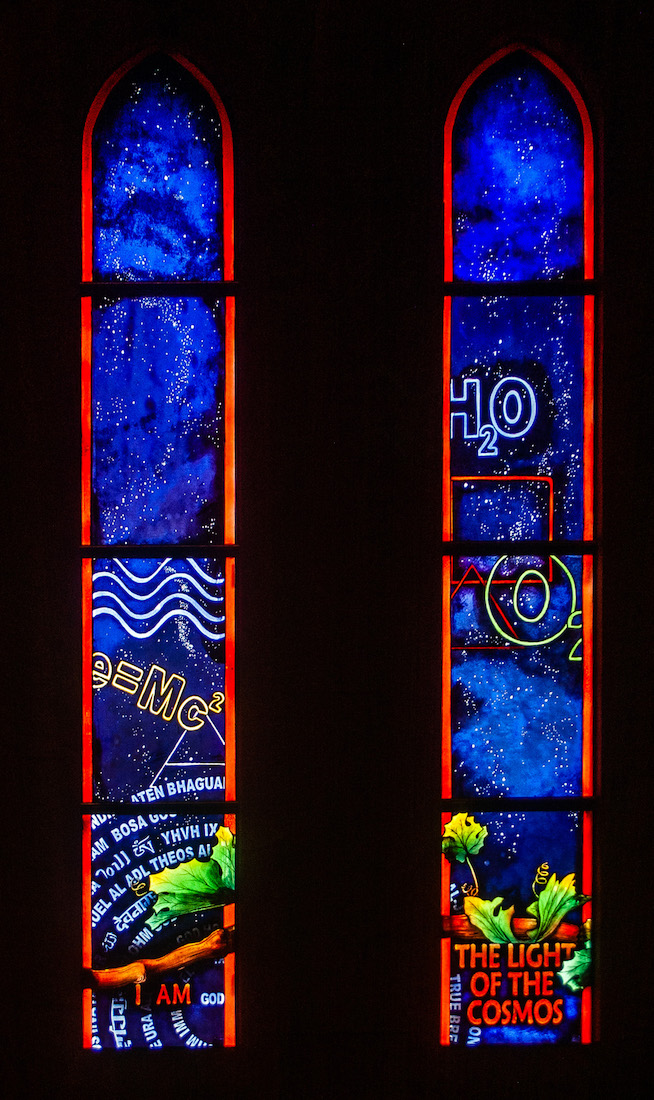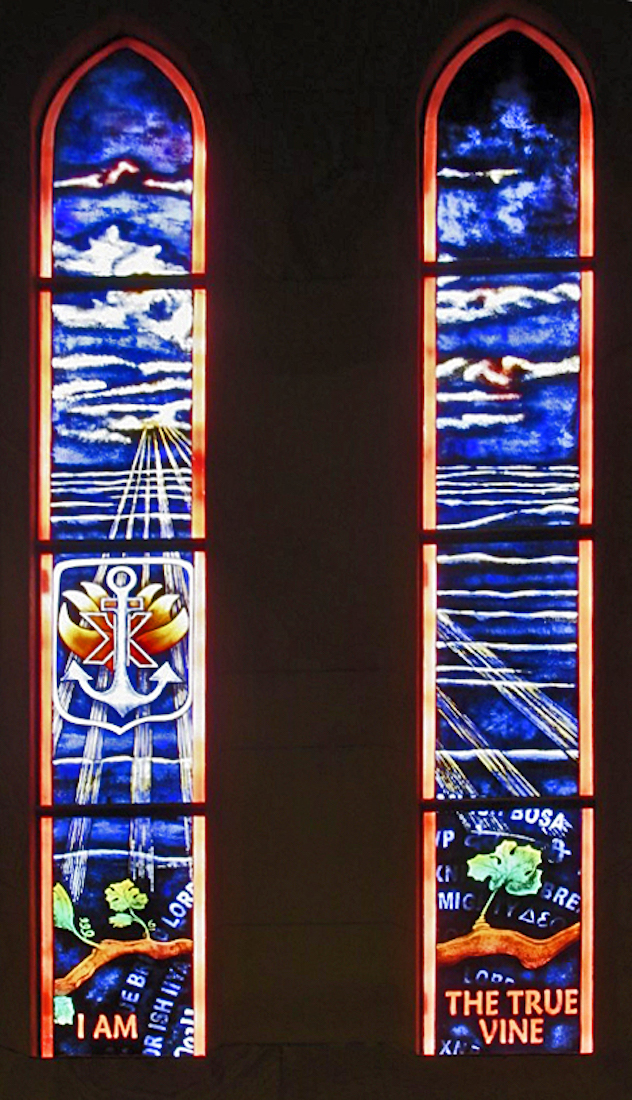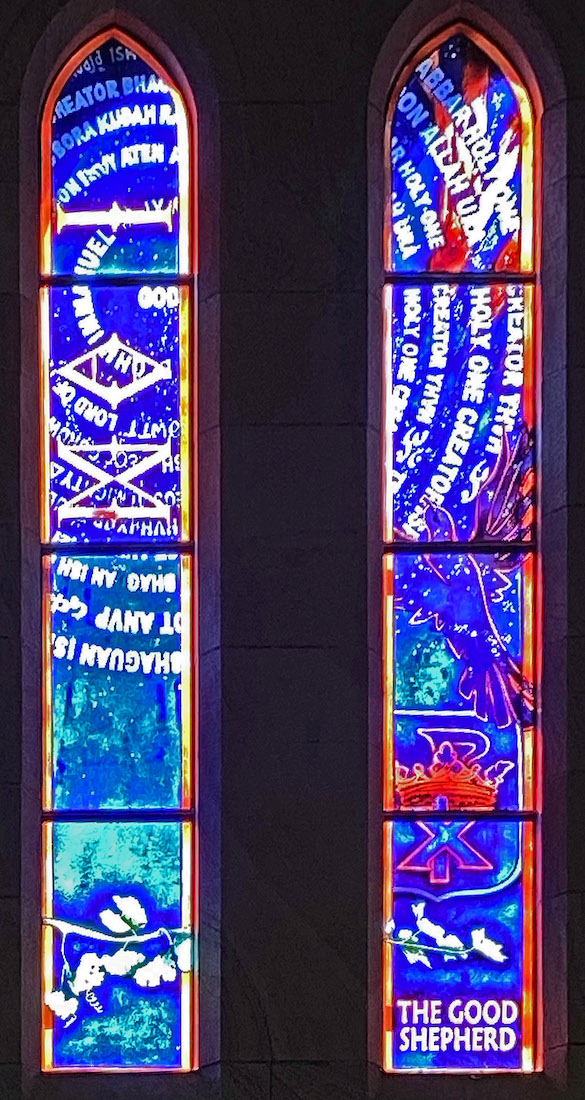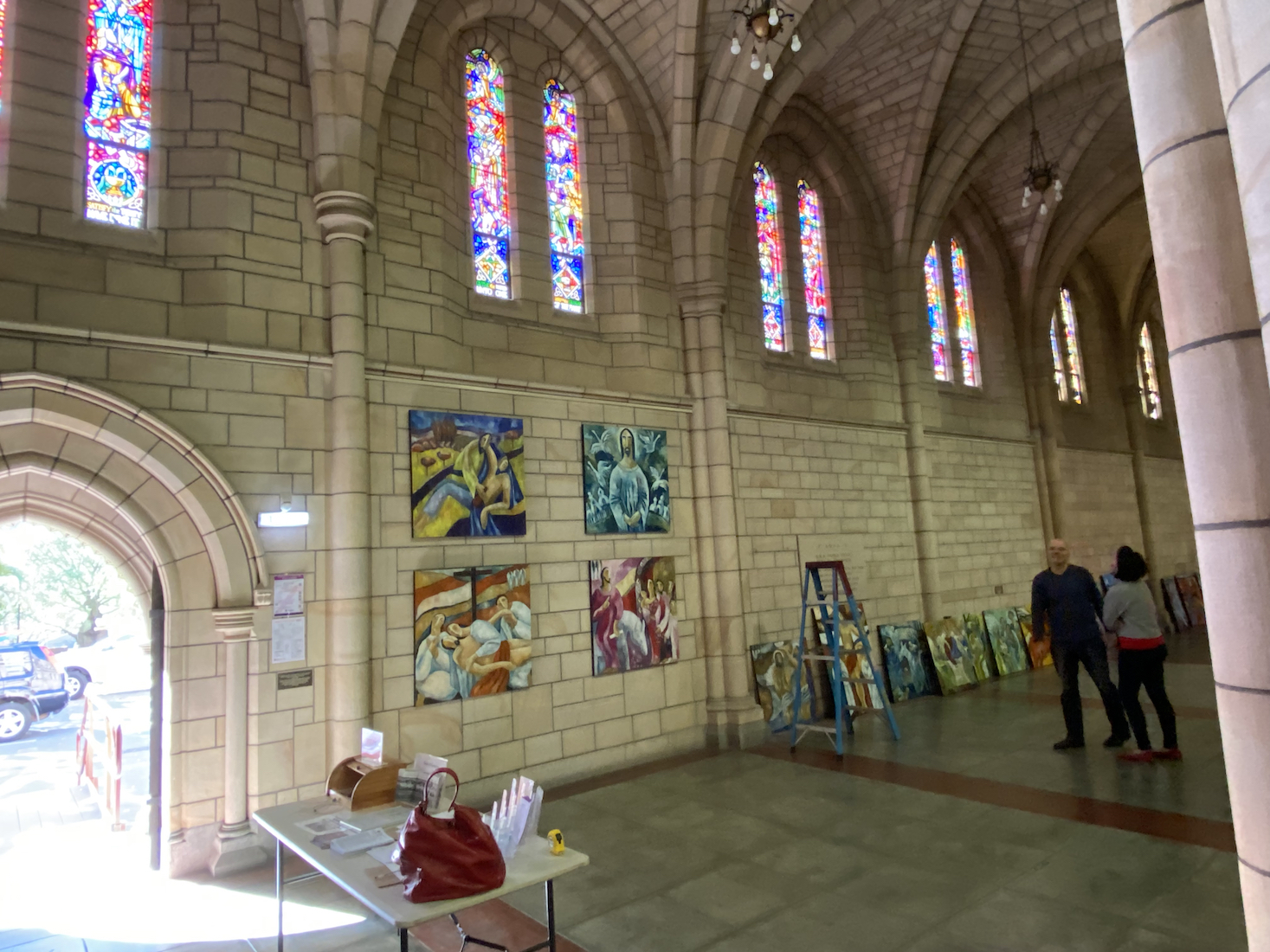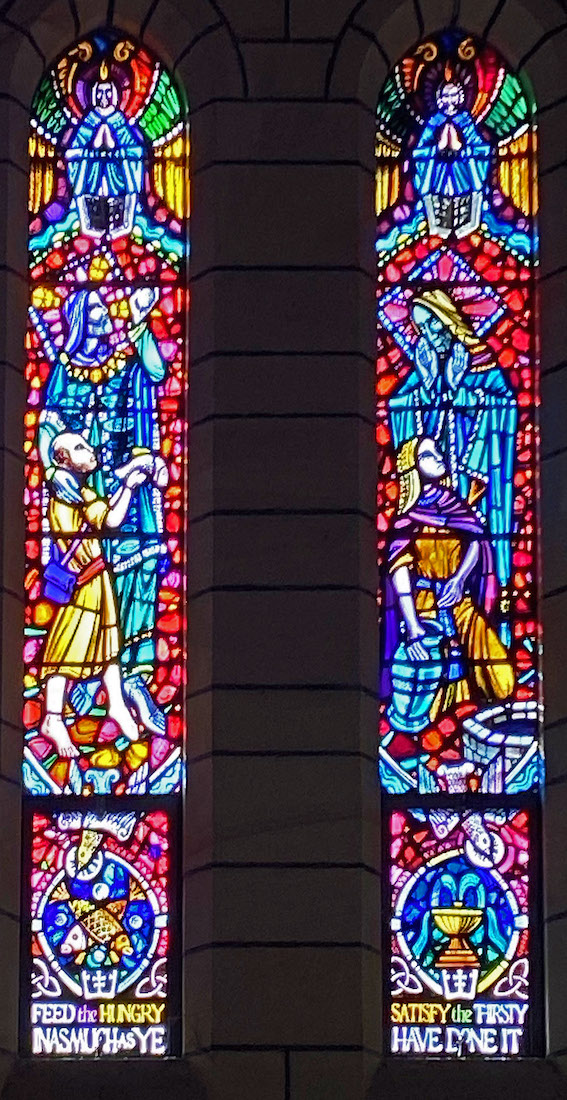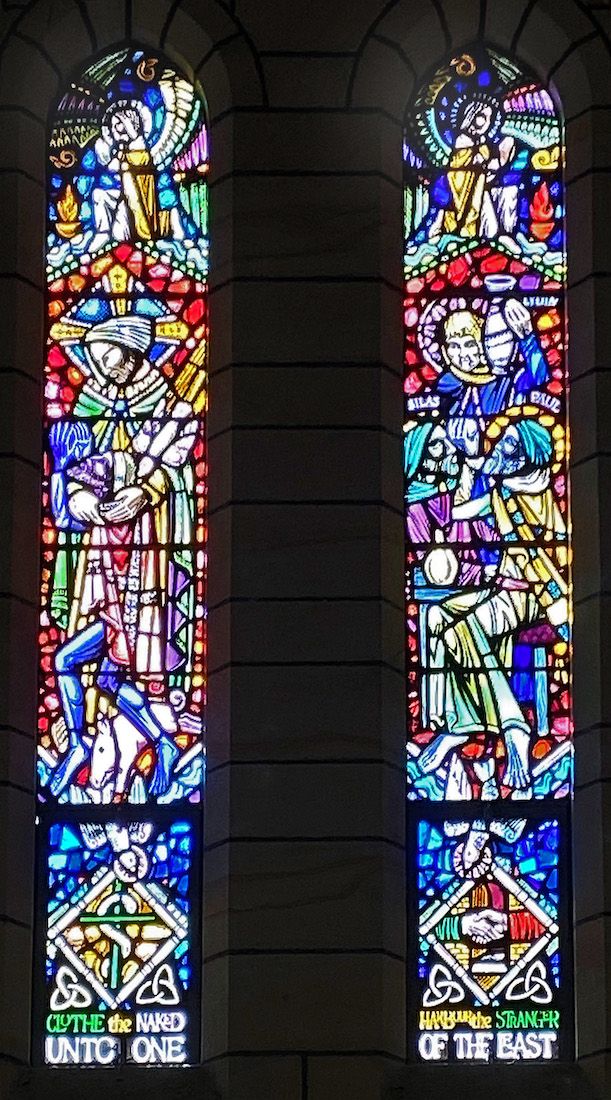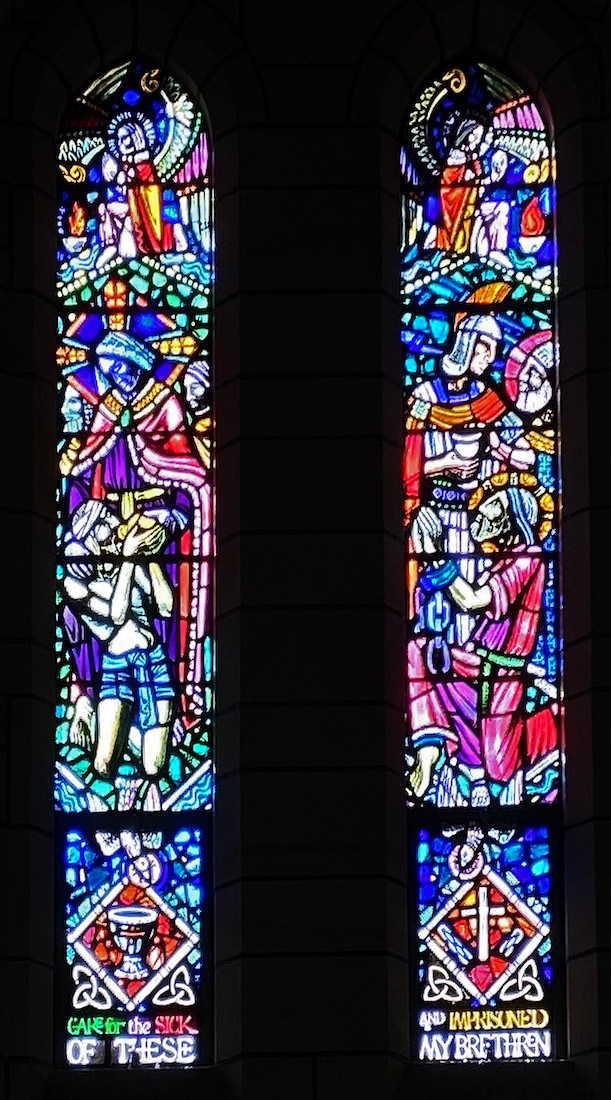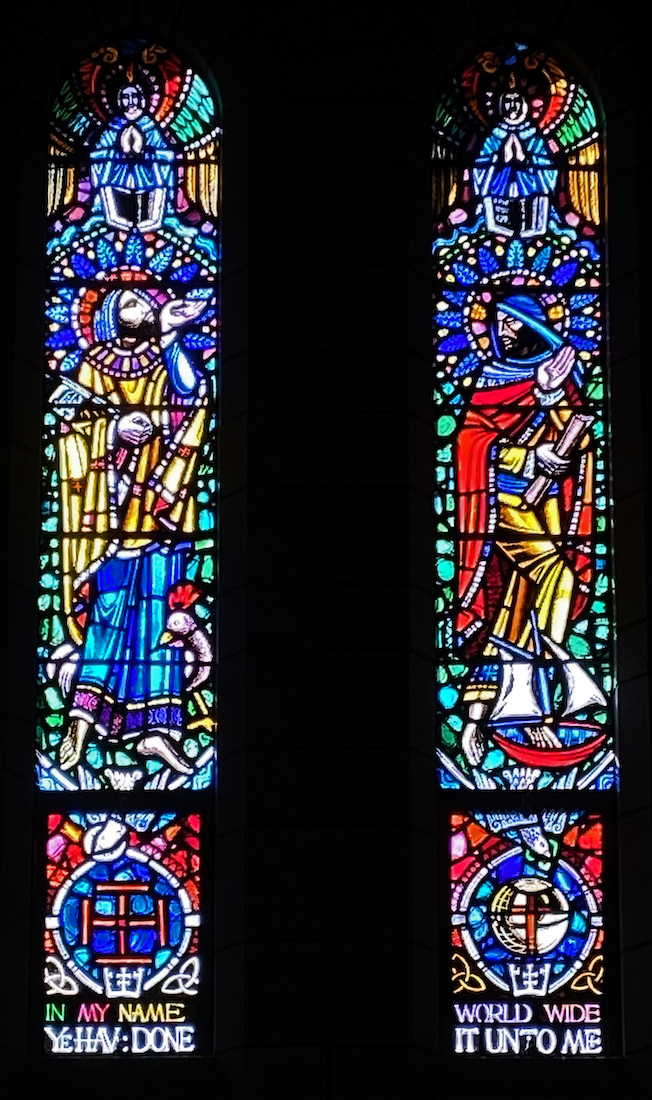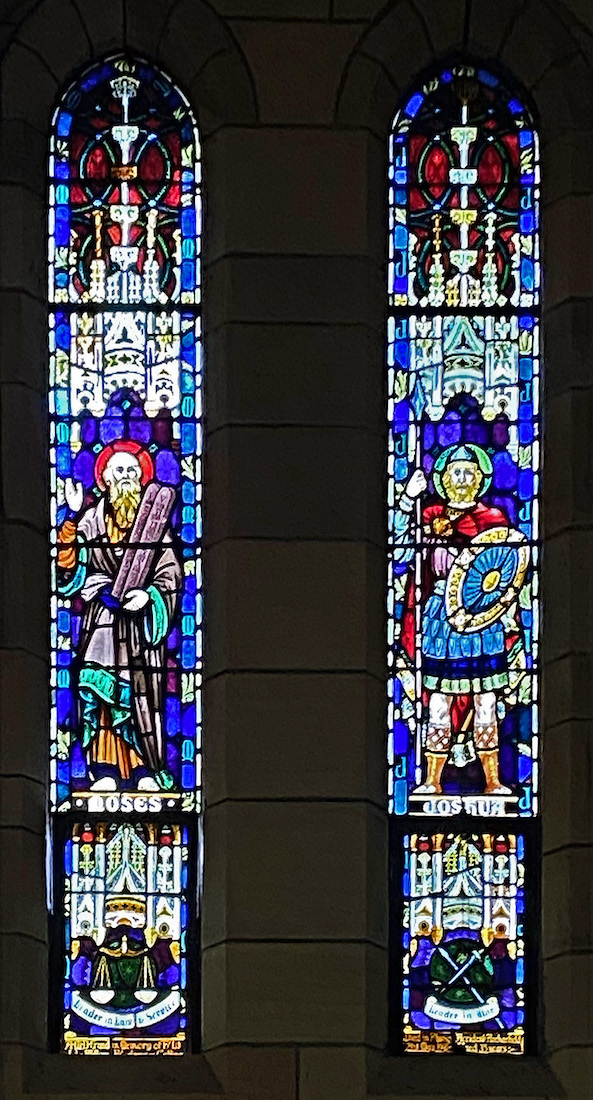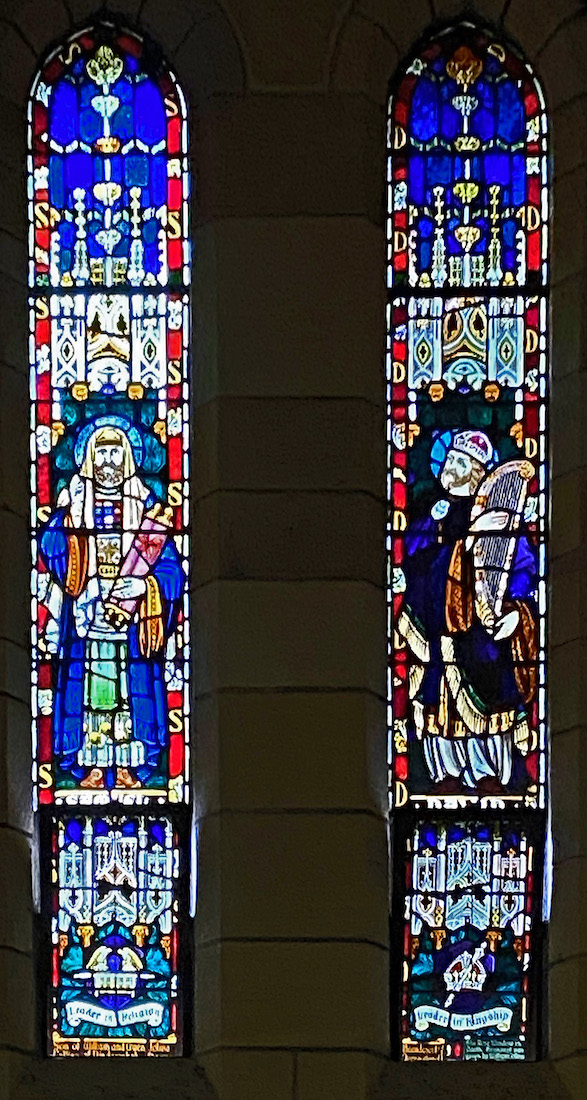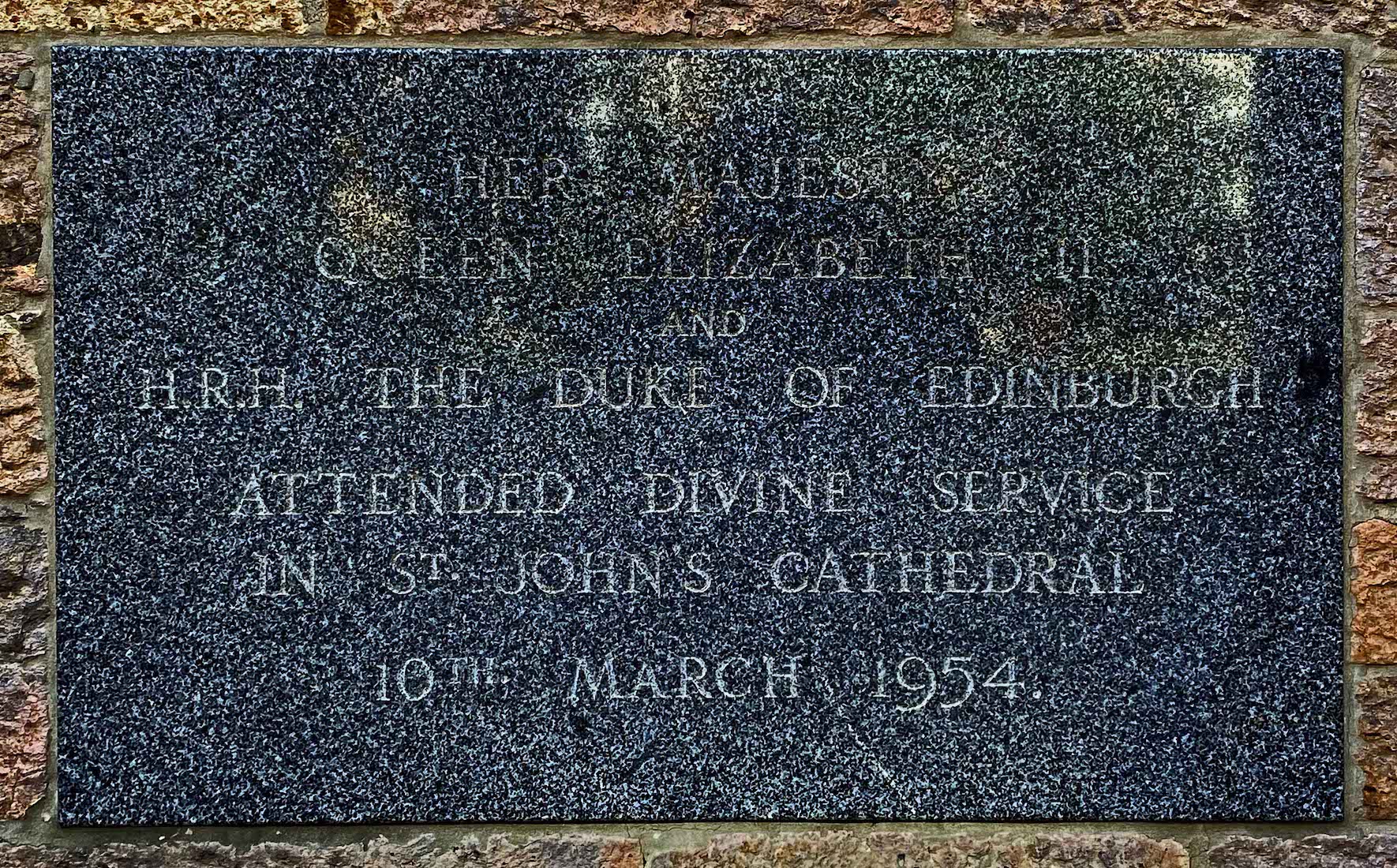
This plaque is on the wall just West of the South Transept entry. It reads: ‘Her Majesty Queen Elizabeth and the Duke of Edinburgh attended Divine Service at St John’s Cathedral 10th March 1954’. INDEX
22. BELL TOWER AND FLYING BUTTRESS

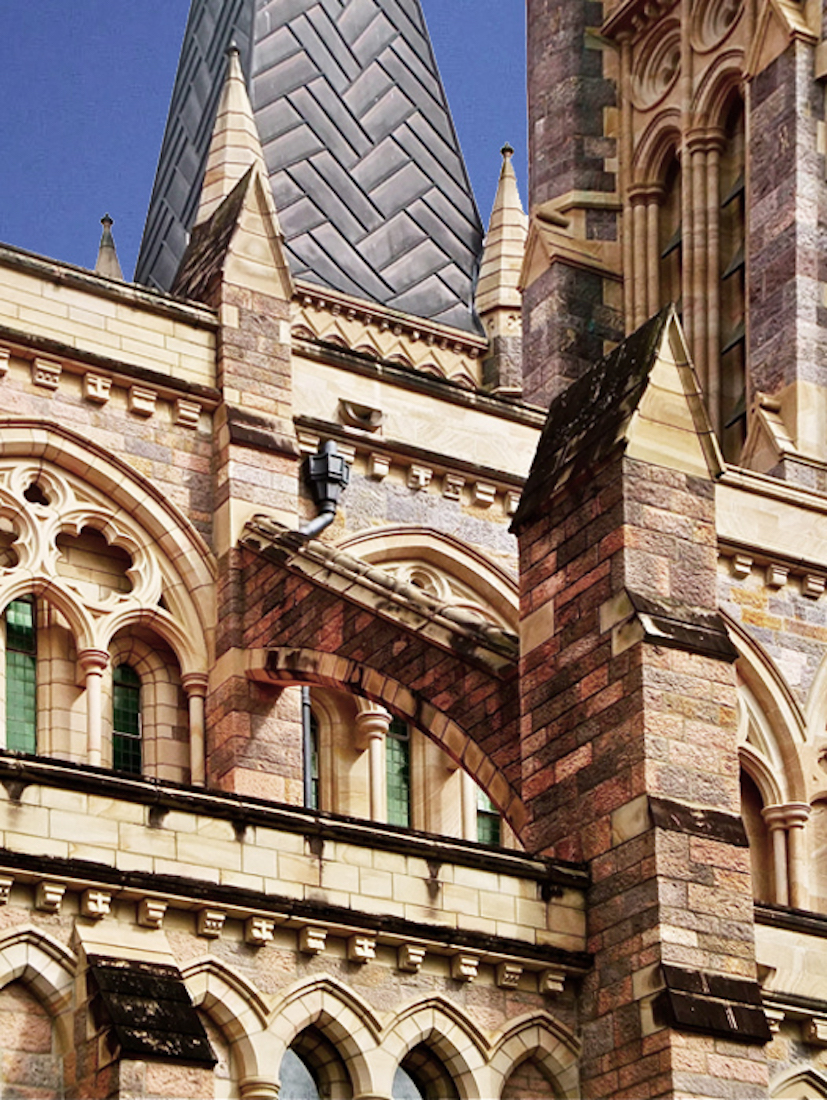
Here are Southern views of the central bell tower and a couple of the flying buttresses. There is a reason that many Gothic structures have flying buttresses. It is because the downward force on a pointed arch is partly deflected sideways. This means that the supporting columns can be more slender, but as well, there needs to be some compensating remedy for the horizontal force component. This is provided by the flying buttress.
23. SOUTH PORTICO
Here is the South portico: all rather grand, and not even the main entrance!
24. SOUTHWEST VIEW
Looking back to the South transept, we observe the Southwest corner of the nave. We shall find inside that this is occupied by the Cathedral shop, with lancet windows occurring in pairs on the two walls. Modern buildings loom above St John’s on all sides.
26. WEST PORTICO – SIDES
The arcaded side porticos to the West entry are a delight: smooth flowing patterns in pastel shades. Two of the six carved bosses are shown. They were designed by children to reveal significant issues of the 20th century: land ecology, Aboriginal land rights, technology, depleted forests, Halley’s comet, land and sea creatures.
27. CENTRAL WEST PORTICO
We walk through the central portico, through the West doors, and into the nave.
28. WELCOME DESK
To our right is a welcomer’s desk, decorated with ‘St John’ eagles.
29. WEST AISLE SOUTH
Beyond the desk, our eyes follow the Southern half of the West aisle, leading to the Australian–American corner.
30. AUSTRALIAN - AMERICAN WINDOWS
Queensland served as an important base for American forces during operations for WWII in the Pacific. Nearly 80,000 Americans were located in Brisbane at the peak of the war. This cooperation is celebrated by these two windows in this corner of the Cathedral narthex. The windows depict two eagles flying towards each other. The wedgetail eagle represents Australia, and the bald eagle signifies the USA. The banner reads ‘Light, Hope, Friendship’ and describes the relationship between the two countries during World war II.
31. WEST AISLE NORTH WINDOWS
In the opposite direction is the North half of the West aisle. There are two windows to be found here too: the Sesquicentenary Windows. These were donated to St John’s by the Catholic Archdiocese on the occasion of the sesquicentenary of the Anglican Diocese of Brisbane.
32. CHI-RHO
We turn now to the central nave aisle. Immediately before us in the floor is a stone bearing the Chi-Rho symbol and the Greek letters Alpha and Omega. These are well known symbols for Christ, with the Chi-Rho being the first two Greek letters for the name ‘Christ’, and Alpha and Omega being the first and last letters of the Greek alphabet – an allusion to Rev 22:13 where Jesus says ‘I am the Alpha and the Omega, the First and the Last’. This was the consecration stone of the completed St John’s Cathedral, dating from a service on 29 October 2009 with Archbishop Philip Aspinall.
33. CENTRAL AISLE WK
The large nave stretches out before us with two rows of rounded columns supporting Gothic arches, marching to the front. Above us the vaulting is all in brick – St John’s is the only Australian Cathedral with this feature. Pulpit, altars and lectern at the front, with colourful apse windows behind. This is a sacred space with much to explore. [Photo Credit: Wikipedia Kgbo]
34. T0 NORTH NAVE WALL
We climb a few steps, and then our exploration will take us past the chunky baptismal font to the North nave.
35. FONT AND PASCHAL CANDLE
The large square font rests on pillars of fossilized limestone, Fosterley Marble from Weardale, near Durham in England. The font was given in memory of surgeon J. W. Walker of Camden, NSW, and his wife Anne. I remember attending a baptismal service here many years ago in which the water in the font was dramatically swished out over the floor three times! •• Near the font is a Paschal candle standing on a very smart polished wood stand.
36. NORTH NAVE WEST
Several storage cupboards stand unobtrusively in the Northwest corner of the nave. Cathedrals often have problems with storage – particularly with unused chairs. Above the cupboards are three of the Cathedral’s six ‘I AM’ windows.
37. NORTHWEST WINDOWS
Jesus made seven ‘I am’ statements. Six of these have been illustrated by Cathedral windows. The missing statement is ‘I am the way, the truth and the life‘ (John 14:6). There are three ‘I am’ windows in this corner of the Cathedral, and they are shown here. They are: ‘I am the Light of the world’ (John 8:12); I am the true Vine (John 15:1, 5); and ‘I am the good Shepherd’ (John 10:11, 14).
38. NORTH WALL EAST OF DOOR
We continue our exploration of the North nave, passing the North door. It just happens that a painting exhibition is being set up during my visit. Counting the window above the North door, there are six more windows along this wall. The first four are of the same type.
39. NORTH NAVE WINDOWS
These four windows are based on Matthew 25:34–40. Verse 40 appears across the bottom of the windows: ‘... Inasmuch as ye did it unto one of the least of these my brethren, ye have done it unto me’. Individual windows pick up words in the previous verses: Feed the hungry, satisfy the thirsty, clothe the naked, harbour the stranger, care for the sick and imprisoned, [in my name, world wide].
40. MORE NORTH NAVE WINDOWS
The next two window pairs on this wall illustrate characters from the Old Testament. At left we see Moses carrying the Tablets of the Law, and the warrior Joshua. At right are Samuel, and King David playing his harp.


